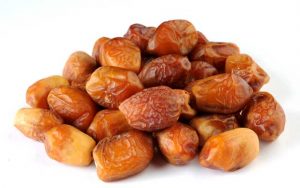Dates Ripening
Some high-quality dates are picked individually by hand, but most are harvested by cutting off the entire cluster. Dates Ripening In North Africa, the harvesters climb the palms, use forked sticks or ropes to lower the fruit clusters, or they may pass the clusters carefully down from hand to hand.
Botany of the Dates
Growers in California and Saudi Arabia use various mechanized means to expedite harvesting-saddles, extension ladders, or mobile steel towers with catwalks for pickers. All fruits in a cluster and all clusters on a palm do not ripen at the same time.
A number of pickings may have to be made over a period of several weeks.
In the Coachella Valley, dates ripen from late September through December and there are 6 to 8 pickings per palm.
Dates go through 4 stages of development:
1) Chirm, or Kari, stage, the first 17 weeks after pollination:
green, hard, bitter, 80% moisture, 50% sugars (glucose and fructose) by dry weight;

